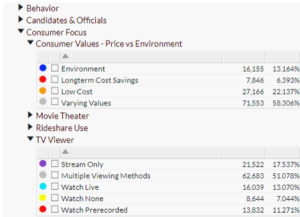HaystaqDNA’s Predictive Microtargeting – Growing your audiences
Download a PDF of the Case Study
Microtargeting has historically been used by political campaigns to not only identify potential supporters, but to track individual voters. Its success comes in its ability to craft tailored messages to the identifiable targeted subgroup. As the digital footprint of millions of Americans grows larger, so does the ability to identify an individual’s disposition. Campaigns have learned that rather than a single television advertisement, multiple tailored messages to smaller audiences can be more effective. Ensuring your message is in the spoken language of the targeted individual is essential. Today businesses and organizations alike have begun adopting many of these microtargeting practices due to their cost, accuracy, and success rate.
As campaigns and marketing teams rely further on targeted advertisement, it’s no longer just about reaching the masses, as much as reaching individuals susceptible to the message. Finding those to target has become an increasingly difficult task for many organizations and companies to handle internally. Many however, underutilize their ability to reach more consumers with data already in their possession. Whether it’s a campaign that’s fundraising or a NGO that is phone banking, data utilization is essential in growing one’s business. At Haystaq, our ability to import your data, model, and score, ensures a cost-effective advertising strategy that targets consumers that are receptive to the media we are delivering.
Our data modeling has been used in multiple industries including healthcare, retail, education, entertainment, and professional sports. The basis for our scores comes from our ability to identify individuals. With over 220 million adults 18+ and by continuously updating our national issue scores we maintain a database that allows us not only to identify and match, but to create custom models that provide clients with exactly what they need. From hot button issues, to state and local concerns our scores cover a wide range of topics. These scores paint a picture of individual personality and interests.
Perhaps the most important part of this process is matching the data provided by the client to our records. We can work with what we are given. Our list matching can be done with the most basic individual information like name and address. The match rate depends on the amount of information given as well as the integrity of the information provided. By matching we can connect individual records provided by the client, to their larger digital footprint. This additional information gives the client the latitude to decide how they want to target this individual.
Next we move to translating the data for our models. This allows us to rank the individuals based on the specifications needed. After our models run we look at the attributes of individuals who score highly and report this information back to the client for insight. With candidate support and donor/fundraising models, our proprietary modeling gives clients lists that will best serve them. Scores are important to understanding demographics, views on issues, as well as home life and financial standing.
Recently, we did a project in the state of California where we received statewide membership data on over 10,000 members. We were able to build out models and apply the score to all 20 million+ voters in the state. This allowed advocacy organizations to then target for new members throughout the state, including areas that they previously were not in. At Haystaq we specialize in reading and combining client data in order to expand the targeted audience.
We are then able to split individuals into ranked tiers, based on their level of support. With other indicators this allowed the client to choose what groups of individuals to target per region. These lists can be used for mail/email campaigns with our cell phone indicator allowing for sms and text message based campaigns. In the past we have used this to help clients find new car buyers, restaurant goers, solar panel owners and more. The technology at our disposal allows us to engage in targeted advertising in new and complex ways. We increase the precision and accuracy of our marketing by knowing specific traits, preferences, and interests of the average American.
